Managing Absenteeism: A Report on Imperial Hotel, London's Challenges
VerifiedAdded on 2020/01/28
|9
|2933
|57
Report
AI Summary
This report analyzes the issue of absenteeism at the Imperial Hotel, London, identifying its impact on staff performance, productivity, and customer satisfaction. The report delves into the causes of absenteeism, including illness, work-life conflicts, and lack of motivation, supported by relevant literature. It explores the financial and operational consequences of employee absence, such as increased costs and decreased morale. Furthermore, the report suggests practical management strategies, including policy frameworks, incentives, and fostering a positive attendance culture, to effectively monitor and reduce absenteeism. The conclusion emphasizes the importance of addressing work-life balance and implementing long-term strategies to improve employee attendance and overall hotel performance. The report recommends specific actions like reducing paid sick leave, offering extra workdays, and incentivizing good attendance.
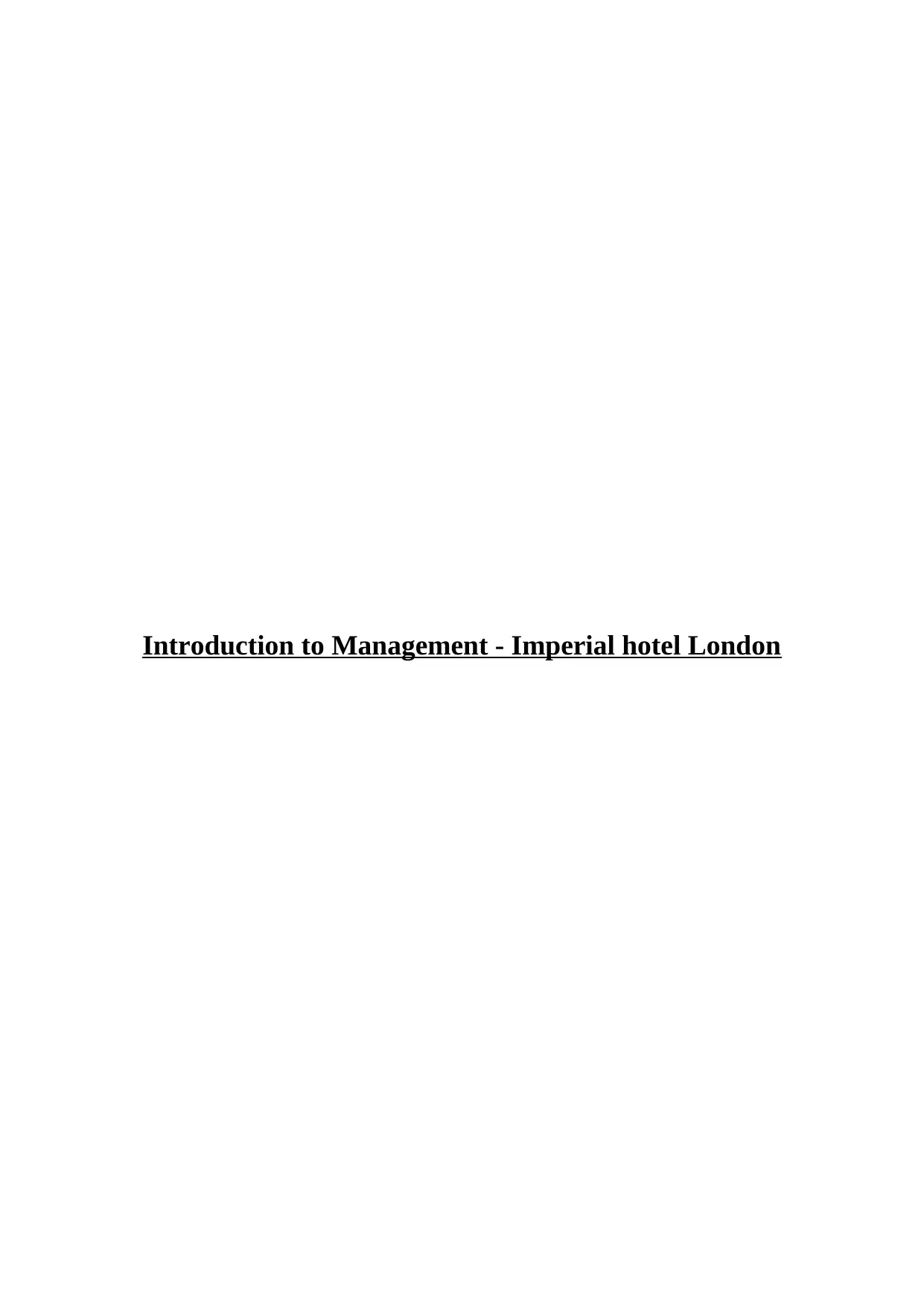
Introduction to Management - Imperial hotel London
Paraphrase This Document
Need a fresh take? Get an instant paraphrase of this document with our AI Paraphraser
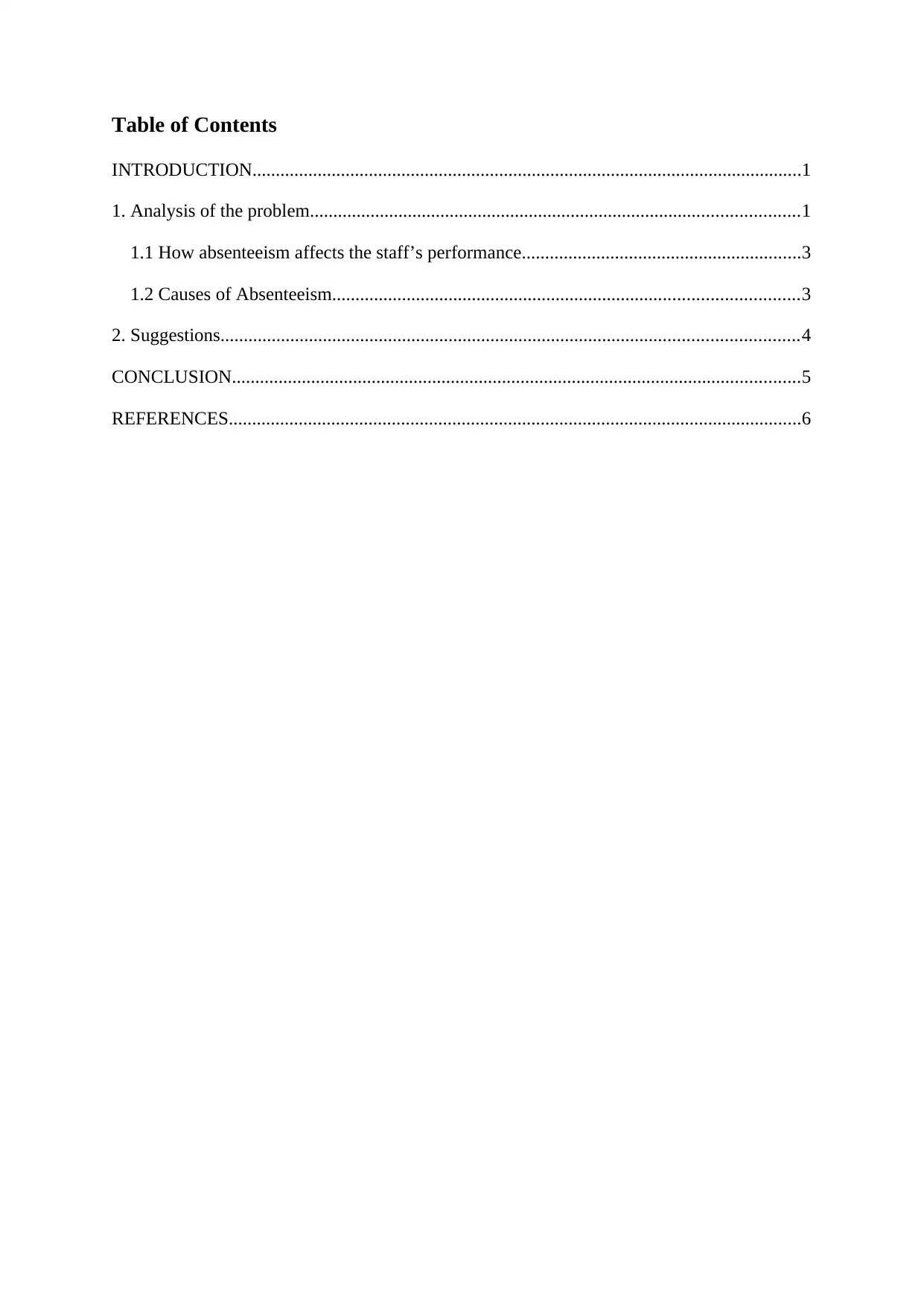
Table of Contents
INTRODUCTION......................................................................................................................1
1. Analysis of the problem.........................................................................................................1
1.1 How absenteeism affects the staff’s performance............................................................3
1.2 Causes of Absenteeism....................................................................................................3
2. Suggestions............................................................................................................................4
CONCLUSION..........................................................................................................................5
REFERENCES...........................................................................................................................6
INTRODUCTION......................................................................................................................1
1. Analysis of the problem.........................................................................................................1
1.1 How absenteeism affects the staff’s performance............................................................3
1.2 Causes of Absenteeism....................................................................................................3
2. Suggestions............................................................................................................................4
CONCLUSION..........................................................................................................................5
REFERENCES...........................................................................................................................6
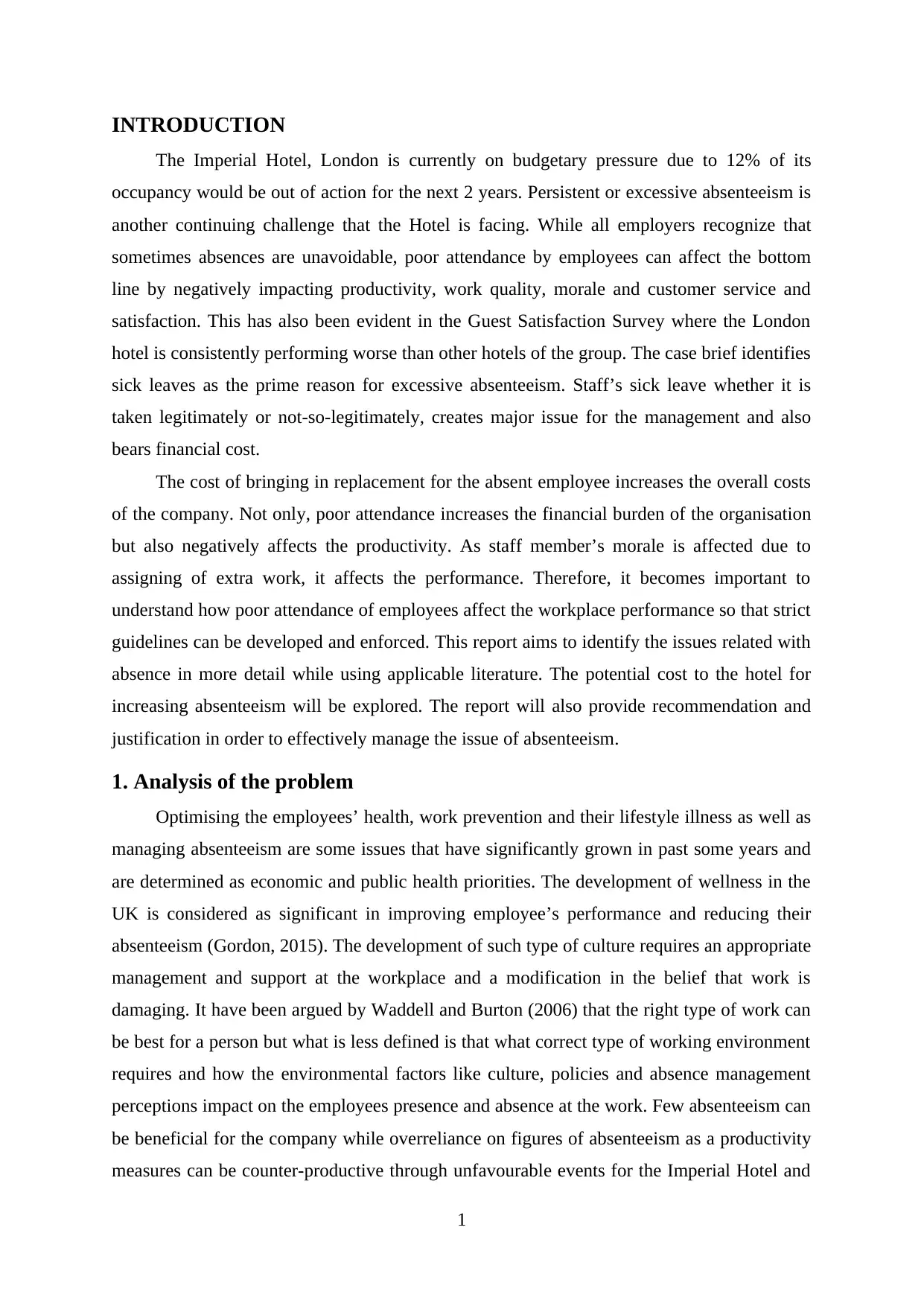
INTRODUCTION
The Imperial Hotel, London is currently on budgetary pressure due to 12% of its
occupancy would be out of action for the next 2 years. Persistent or excessive absenteeism is
another continuing challenge that the Hotel is facing. While all employers recognize that
sometimes absences are unavoidable, poor attendance by employees can affect the bottom
line by negatively impacting productivity, work quality, morale and customer service and
satisfaction. This has also been evident in the Guest Satisfaction Survey where the London
hotel is consistently performing worse than other hotels of the group. The case brief identifies
sick leaves as the prime reason for excessive absenteeism. Staff’s sick leave whether it is
taken legitimately or not-so-legitimately, creates major issue for the management and also
bears financial cost.
The cost of bringing in replacement for the absent employee increases the overall costs
of the company. Not only, poor attendance increases the financial burden of the organisation
but also negatively affects the productivity. As staff member’s morale is affected due to
assigning of extra work, it affects the performance. Therefore, it becomes important to
understand how poor attendance of employees affect the workplace performance so that strict
guidelines can be developed and enforced. This report aims to identify the issues related with
absence in more detail while using applicable literature. The potential cost to the hotel for
increasing absenteeism will be explored. The report will also provide recommendation and
justification in order to effectively manage the issue of absenteeism.
1. Analysis of the problem
Optimising the employees’ health, work prevention and their lifestyle illness as well as
managing absenteeism are some issues that have significantly grown in past some years and
are determined as economic and public health priorities. The development of wellness in the
UK is considered as significant in improving employee’s performance and reducing their
absenteeism (Gordon, 2015). The development of such type of culture requires an appropriate
management and support at the workplace and a modification in the belief that work is
damaging. It have been argued by Waddell and Burton (2006) that the right type of work can
be best for a person but what is less defined is that what correct type of working environment
requires and how the environmental factors like culture, policies and absence management
perceptions impact on the employees presence and absence at the work. Few absenteeism can
be beneficial for the company while overreliance on figures of absenteeism as a productivity
measures can be counter-productive through unfavourable events for the Imperial Hotel and
1
The Imperial Hotel, London is currently on budgetary pressure due to 12% of its
occupancy would be out of action for the next 2 years. Persistent or excessive absenteeism is
another continuing challenge that the Hotel is facing. While all employers recognize that
sometimes absences are unavoidable, poor attendance by employees can affect the bottom
line by negatively impacting productivity, work quality, morale and customer service and
satisfaction. This has also been evident in the Guest Satisfaction Survey where the London
hotel is consistently performing worse than other hotels of the group. The case brief identifies
sick leaves as the prime reason for excessive absenteeism. Staff’s sick leave whether it is
taken legitimately or not-so-legitimately, creates major issue for the management and also
bears financial cost.
The cost of bringing in replacement for the absent employee increases the overall costs
of the company. Not only, poor attendance increases the financial burden of the organisation
but also negatively affects the productivity. As staff member’s morale is affected due to
assigning of extra work, it affects the performance. Therefore, it becomes important to
understand how poor attendance of employees affect the workplace performance so that strict
guidelines can be developed and enforced. This report aims to identify the issues related with
absence in more detail while using applicable literature. The potential cost to the hotel for
increasing absenteeism will be explored. The report will also provide recommendation and
justification in order to effectively manage the issue of absenteeism.
1. Analysis of the problem
Optimising the employees’ health, work prevention and their lifestyle illness as well as
managing absenteeism are some issues that have significantly grown in past some years and
are determined as economic and public health priorities. The development of wellness in the
UK is considered as significant in improving employee’s performance and reducing their
absenteeism (Gordon, 2015). The development of such type of culture requires an appropriate
management and support at the workplace and a modification in the belief that work is
damaging. It have been argued by Waddell and Burton (2006) that the right type of work can
be best for a person but what is less defined is that what correct type of working environment
requires and how the environmental factors like culture, policies and absence management
perceptions impact on the employees presence and absence at the work. Few absenteeism can
be beneficial for the company while overreliance on figures of absenteeism as a productivity
measures can be counter-productive through unfavourable events for the Imperial Hotel and
1
⊘ This is a preview!⊘
Do you want full access?
Subscribe today to unlock all pages.

Trusted by 1+ million students worldwide
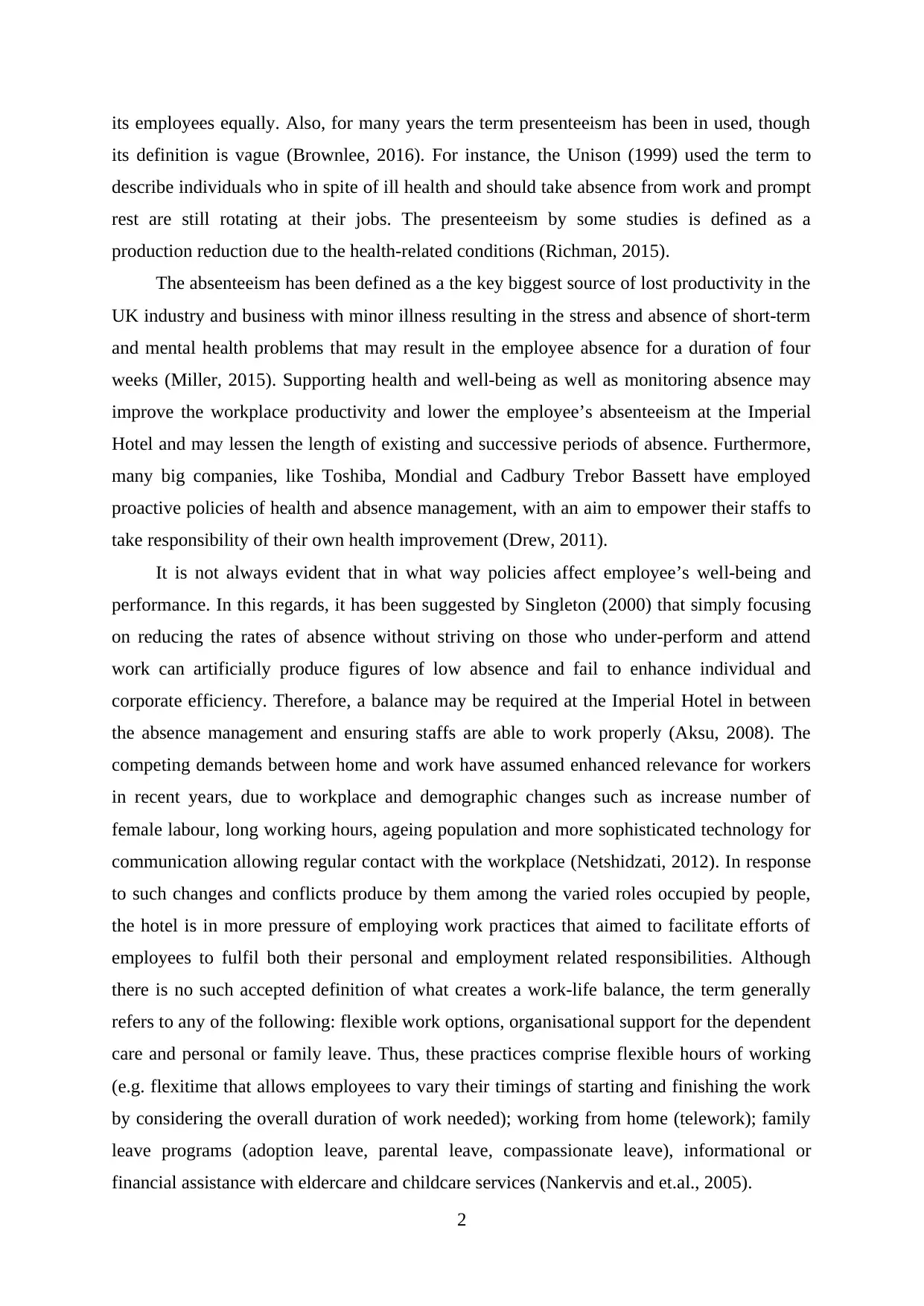
its employees equally. Also, for many years the term presenteeism has been in used, though
its definition is vague (Brownlee, 2016). For instance, the Unison (1999) used the term to
describe individuals who in spite of ill health and should take absence from work and prompt
rest are still rotating at their jobs. The presenteeism by some studies is defined as a
production reduction due to the health-related conditions (Richman, 2015).
The absenteeism has been defined as a the key biggest source of lost productivity in the
UK industry and business with minor illness resulting in the stress and absence of short-term
and mental health problems that may result in the employee absence for a duration of four
weeks (Miller, 2015). Supporting health and well-being as well as monitoring absence may
improve the workplace productivity and lower the employee’s absenteeism at the Imperial
Hotel and may lessen the length of existing and successive periods of absence. Furthermore,
many big companies, like Toshiba, Mondial and Cadbury Trebor Bassett have employed
proactive policies of health and absence management, with an aim to empower their staffs to
take responsibility of their own health improvement (Drew, 2011).
It is not always evident that in what way policies affect employee’s well-being and
performance. In this regards, it has been suggested by Singleton (2000) that simply focusing
on reducing the rates of absence without striving on those who under-perform and attend
work can artificially produce figures of low absence and fail to enhance individual and
corporate efficiency. Therefore, a balance may be required at the Imperial Hotel in between
the absence management and ensuring staffs are able to work properly (Aksu, 2008). The
competing demands between home and work have assumed enhanced relevance for workers
in recent years, due to workplace and demographic changes such as increase number of
female labour, long working hours, ageing population and more sophisticated technology for
communication allowing regular contact with the workplace (Netshidzati, 2012). In response
to such changes and conflicts produce by them among the varied roles occupied by people,
the hotel is in more pressure of employing work practices that aimed to facilitate efforts of
employees to fulfil both their personal and employment related responsibilities. Although
there is no such accepted definition of what creates a work-life balance, the term generally
refers to any of the following: flexible work options, organisational support for the dependent
care and personal or family leave. Thus, these practices comprise flexible hours of working
(e.g. flexitime that allows employees to vary their timings of starting and finishing the work
by considering the overall duration of work needed); working from home (telework); family
leave programs (adoption leave, parental leave, compassionate leave), informational or
financial assistance with eldercare and childcare services (Nankervis and et.al., 2005).
2
its definition is vague (Brownlee, 2016). For instance, the Unison (1999) used the term to
describe individuals who in spite of ill health and should take absence from work and prompt
rest are still rotating at their jobs. The presenteeism by some studies is defined as a
production reduction due to the health-related conditions (Richman, 2015).
The absenteeism has been defined as a the key biggest source of lost productivity in the
UK industry and business with minor illness resulting in the stress and absence of short-term
and mental health problems that may result in the employee absence for a duration of four
weeks (Miller, 2015). Supporting health and well-being as well as monitoring absence may
improve the workplace productivity and lower the employee’s absenteeism at the Imperial
Hotel and may lessen the length of existing and successive periods of absence. Furthermore,
many big companies, like Toshiba, Mondial and Cadbury Trebor Bassett have employed
proactive policies of health and absence management, with an aim to empower their staffs to
take responsibility of their own health improvement (Drew, 2011).
It is not always evident that in what way policies affect employee’s well-being and
performance. In this regards, it has been suggested by Singleton (2000) that simply focusing
on reducing the rates of absence without striving on those who under-perform and attend
work can artificially produce figures of low absence and fail to enhance individual and
corporate efficiency. Therefore, a balance may be required at the Imperial Hotel in between
the absence management and ensuring staffs are able to work properly (Aksu, 2008). The
competing demands between home and work have assumed enhanced relevance for workers
in recent years, due to workplace and demographic changes such as increase number of
female labour, long working hours, ageing population and more sophisticated technology for
communication allowing regular contact with the workplace (Netshidzati, 2012). In response
to such changes and conflicts produce by them among the varied roles occupied by people,
the hotel is in more pressure of employing work practices that aimed to facilitate efforts of
employees to fulfil both their personal and employment related responsibilities. Although
there is no such accepted definition of what creates a work-life balance, the term generally
refers to any of the following: flexible work options, organisational support for the dependent
care and personal or family leave. Thus, these practices comprise flexible hours of working
(e.g. flexitime that allows employees to vary their timings of starting and finishing the work
by considering the overall duration of work needed); working from home (telework); family
leave programs (adoption leave, parental leave, compassionate leave), informational or
financial assistance with eldercare and childcare services (Nankervis and et.al., 2005).
2
Paraphrase This Document
Need a fresh take? Get an instant paraphrase of this document with our AI Paraphraser
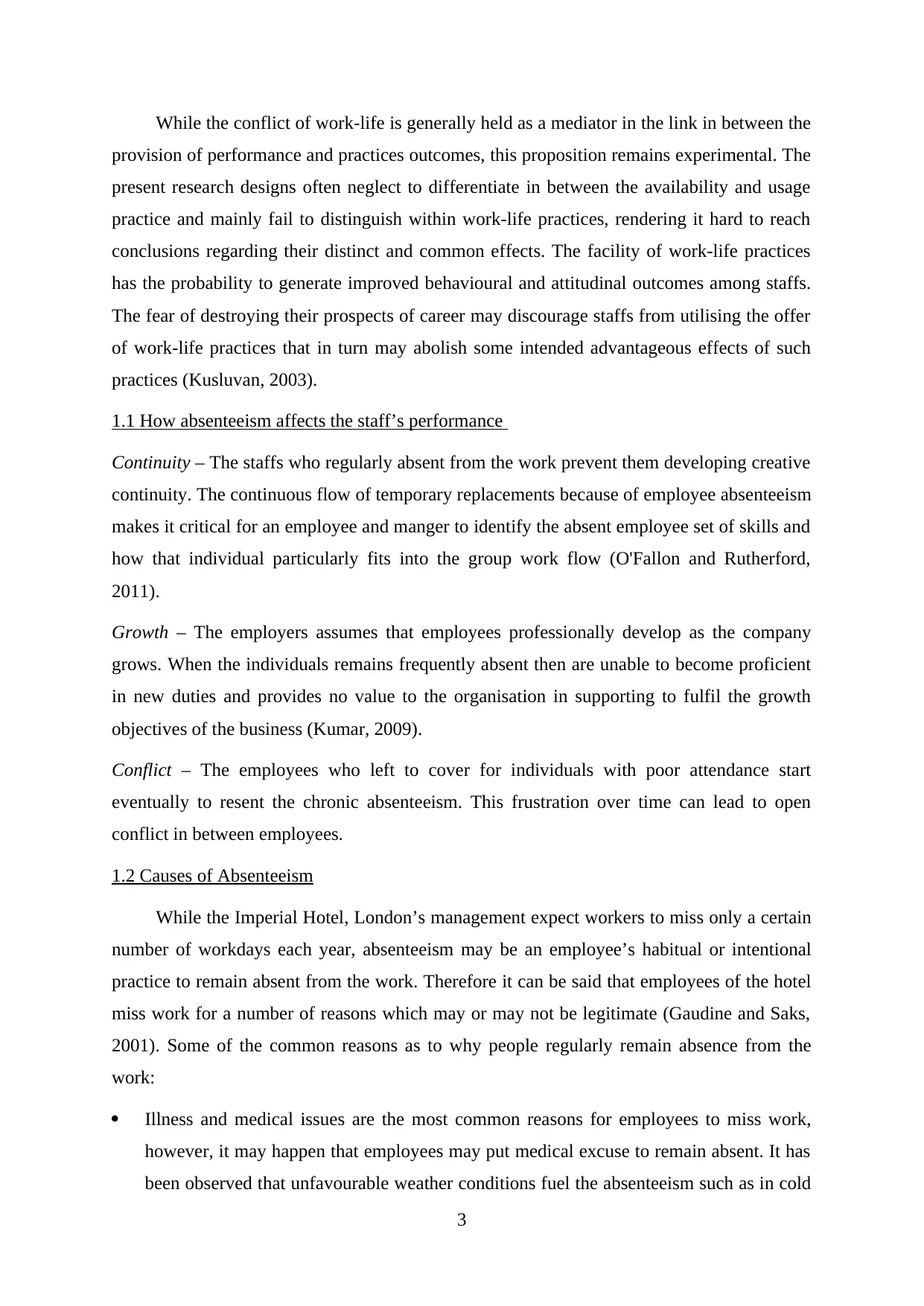
While the conflict of work-life is generally held as a mediator in the link in between the
provision of performance and practices outcomes, this proposition remains experimental. The
present research designs often neglect to differentiate in between the availability and usage
practice and mainly fail to distinguish within work-life practices, rendering it hard to reach
conclusions regarding their distinct and common effects. The facility of work-life practices
has the probability to generate improved behavioural and attitudinal outcomes among staffs.
The fear of destroying their prospects of career may discourage staffs from utilising the offer
of work-life practices that in turn may abolish some intended advantageous effects of such
practices (Kusluvan, 2003).
1.1 How absenteeism affects the staff’s performance
Continuity – The staffs who regularly absent from the work prevent them developing creative
continuity. The continuous flow of temporary replacements because of employee absenteeism
makes it critical for an employee and manger to identify the absent employee set of skills and
how that individual particularly fits into the group work flow (O'Fallon and Rutherford,
2011).
Growth – The employers assumes that employees professionally develop as the company
grows. When the individuals remains frequently absent then are unable to become proficient
in new duties and provides no value to the organisation in supporting to fulfil the growth
objectives of the business (Kumar, 2009).
Conflict – The employees who left to cover for individuals with poor attendance start
eventually to resent the chronic absenteeism. This frustration over time can lead to open
conflict in between employees.
1.2 Causes of Absenteeism
While the Imperial Hotel, London’s management expect workers to miss only a certain
number of workdays each year, absenteeism may be an employee’s habitual or intentional
practice to remain absent from the work. Therefore it can be said that employees of the hotel
miss work for a number of reasons which may or may not be legitimate (Gaudine and Saks,
2001). Some of the common reasons as to why people regularly remain absence from the
work:
Illness and medical issues are the most common reasons for employees to miss work,
however, it may happen that employees may put medical excuse to remain absent. It has
been observed that unfavourable weather conditions fuel the absenteeism such as in cold
3
provision of performance and practices outcomes, this proposition remains experimental. The
present research designs often neglect to differentiate in between the availability and usage
practice and mainly fail to distinguish within work-life practices, rendering it hard to reach
conclusions regarding their distinct and common effects. The facility of work-life practices
has the probability to generate improved behavioural and attitudinal outcomes among staffs.
The fear of destroying their prospects of career may discourage staffs from utilising the offer
of work-life practices that in turn may abolish some intended advantageous effects of such
practices (Kusluvan, 2003).
1.1 How absenteeism affects the staff’s performance
Continuity – The staffs who regularly absent from the work prevent them developing creative
continuity. The continuous flow of temporary replacements because of employee absenteeism
makes it critical for an employee and manger to identify the absent employee set of skills and
how that individual particularly fits into the group work flow (O'Fallon and Rutherford,
2011).
Growth – The employers assumes that employees professionally develop as the company
grows. When the individuals remains frequently absent then are unable to become proficient
in new duties and provides no value to the organisation in supporting to fulfil the growth
objectives of the business (Kumar, 2009).
Conflict – The employees who left to cover for individuals with poor attendance start
eventually to resent the chronic absenteeism. This frustration over time can lead to open
conflict in between employees.
1.2 Causes of Absenteeism
While the Imperial Hotel, London’s management expect workers to miss only a certain
number of workdays each year, absenteeism may be an employee’s habitual or intentional
practice to remain absent from the work. Therefore it can be said that employees of the hotel
miss work for a number of reasons which may or may not be legitimate (Gaudine and Saks,
2001). Some of the common reasons as to why people regularly remain absence from the
work:
Illness and medical issues are the most common reasons for employees to miss work,
however, it may happen that employees may put medical excuse to remain absent. It has
been observed that unfavourable weather conditions fuel the absenteeism such as in cold
3
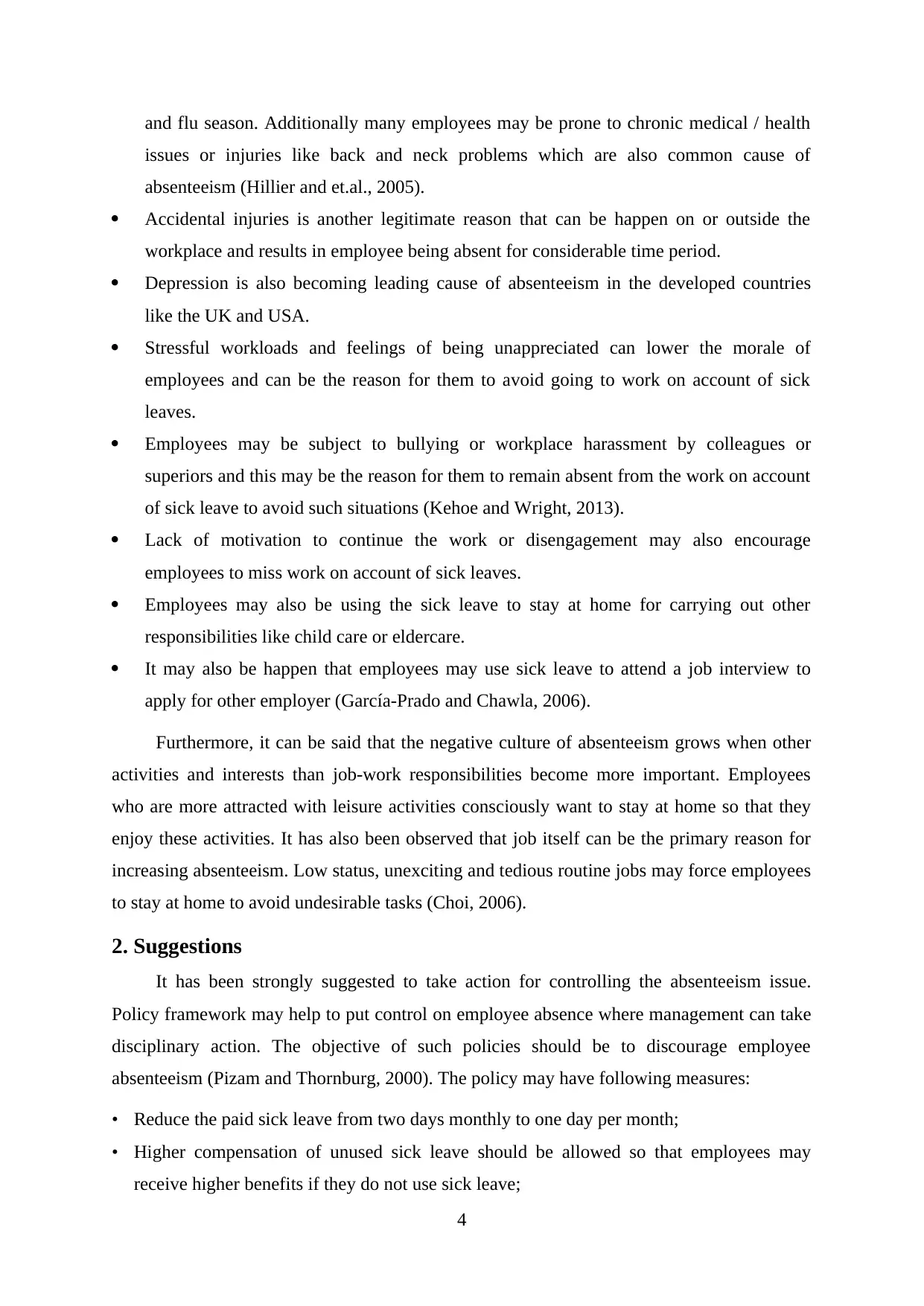
and flu season. Additionally many employees may be prone to chronic medical / health
issues or injuries like back and neck problems which are also common cause of
absenteeism (Hillier and et.al., 2005).
Accidental injuries is another legitimate reason that can be happen on or outside the
workplace and results in employee being absent for considerable time period.
Depression is also becoming leading cause of absenteeism in the developed countries
like the UK and USA.
Stressful workloads and feelings of being unappreciated can lower the morale of
employees and can be the reason for them to avoid going to work on account of sick
leaves.
Employees may be subject to bullying or workplace harassment by colleagues or
superiors and this may be the reason for them to remain absent from the work on account
of sick leave to avoid such situations (Kehoe and Wright, 2013).
Lack of motivation to continue the work or disengagement may also encourage
employees to miss work on account of sick leaves.
Employees may also be using the sick leave to stay at home for carrying out other
responsibilities like child care or eldercare.
It may also be happen that employees may use sick leave to attend a job interview to
apply for other employer (García-Prado and Chawla, 2006).
Furthermore, it can be said that the negative culture of absenteeism grows when other
activities and interests than job-work responsibilities become more important. Employees
who are more attracted with leisure activities consciously want to stay at home so that they
enjoy these activities. It has also been observed that job itself can be the primary reason for
increasing absenteeism. Low status, unexciting and tedious routine jobs may force employees
to stay at home to avoid undesirable tasks (Choi, 2006).
2. Suggestions
It has been strongly suggested to take action for controlling the absenteeism issue.
Policy framework may help to put control on employee absence where management can take
disciplinary action. The objective of such policies should be to discourage employee
absenteeism (Pizam and Thornburg, 2000). The policy may have following measures:
• Reduce the paid sick leave from two days monthly to one day per month;
• Higher compensation of unused sick leave should be allowed so that employees may
receive higher benefits if they do not use sick leave;
4
issues or injuries like back and neck problems which are also common cause of
absenteeism (Hillier and et.al., 2005).
Accidental injuries is another legitimate reason that can be happen on or outside the
workplace and results in employee being absent for considerable time period.
Depression is also becoming leading cause of absenteeism in the developed countries
like the UK and USA.
Stressful workloads and feelings of being unappreciated can lower the morale of
employees and can be the reason for them to avoid going to work on account of sick
leaves.
Employees may be subject to bullying or workplace harassment by colleagues or
superiors and this may be the reason for them to remain absent from the work on account
of sick leave to avoid such situations (Kehoe and Wright, 2013).
Lack of motivation to continue the work or disengagement may also encourage
employees to miss work on account of sick leaves.
Employees may also be using the sick leave to stay at home for carrying out other
responsibilities like child care or eldercare.
It may also be happen that employees may use sick leave to attend a job interview to
apply for other employer (García-Prado and Chawla, 2006).
Furthermore, it can be said that the negative culture of absenteeism grows when other
activities and interests than job-work responsibilities become more important. Employees
who are more attracted with leisure activities consciously want to stay at home so that they
enjoy these activities. It has also been observed that job itself can be the primary reason for
increasing absenteeism. Low status, unexciting and tedious routine jobs may force employees
to stay at home to avoid undesirable tasks (Choi, 2006).
2. Suggestions
It has been strongly suggested to take action for controlling the absenteeism issue.
Policy framework may help to put control on employee absence where management can take
disciplinary action. The objective of such policies should be to discourage employee
absenteeism (Pizam and Thornburg, 2000). The policy may have following measures:
• Reduce the paid sick leave from two days monthly to one day per month;
• Higher compensation of unused sick leave should be allowed so that employees may
receive higher benefits if they do not use sick leave;
4
⊘ This is a preview!⊘
Do you want full access?
Subscribe today to unlock all pages.

Trusted by 1+ million students worldwide
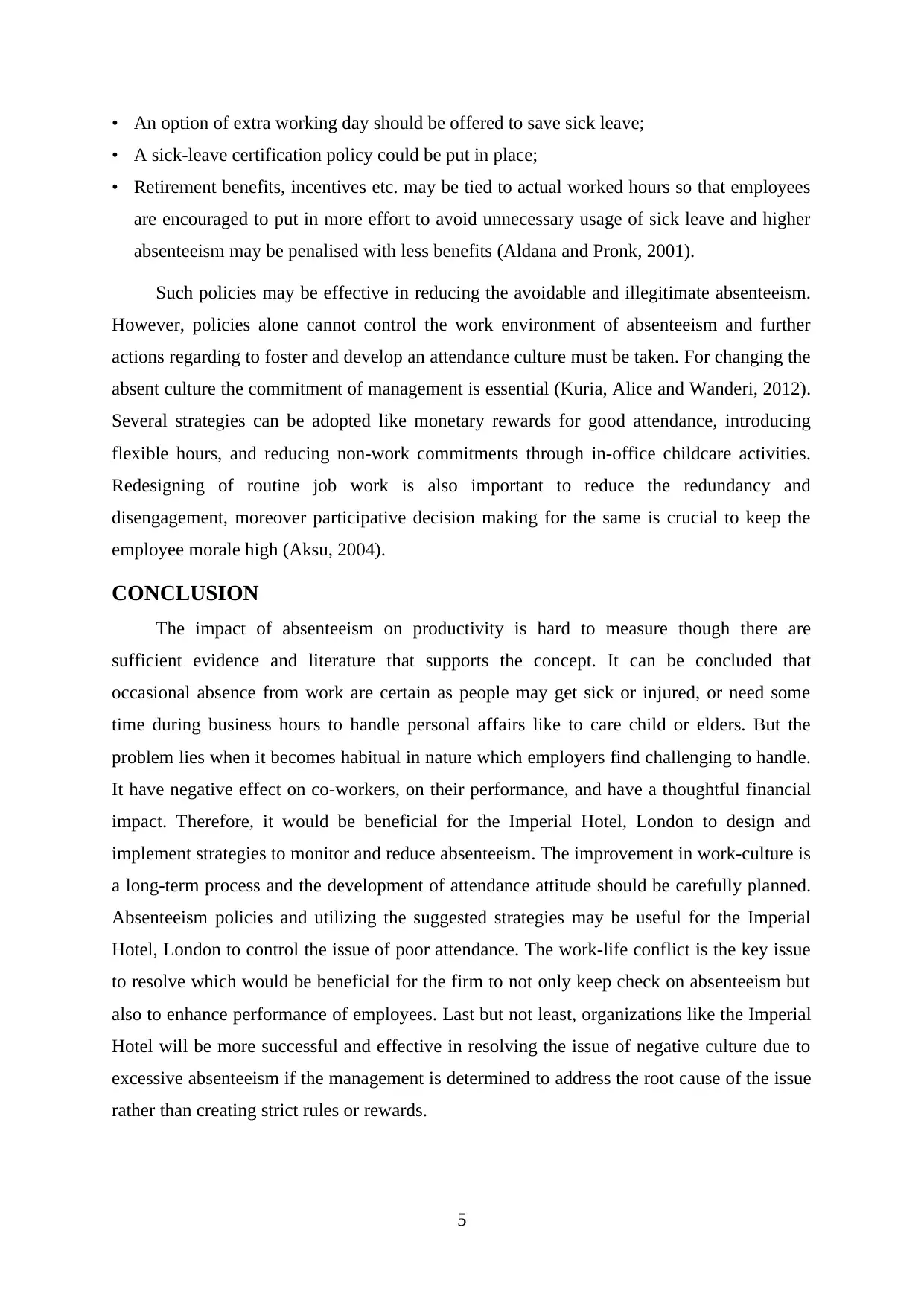
• An option of extra working day should be offered to save sick leave;
• A sick-leave certification policy could be put in place;
• Retirement benefits, incentives etc. may be tied to actual worked hours so that employees
are encouraged to put in more effort to avoid unnecessary usage of sick leave and higher
absenteeism may be penalised with less benefits (Aldana and Pronk, 2001).
Such policies may be effective in reducing the avoidable and illegitimate absenteeism.
However, policies alone cannot control the work environment of absenteeism and further
actions regarding to foster and develop an attendance culture must be taken. For changing the
absent culture the commitment of management is essential (Kuria, Alice and Wanderi, 2012).
Several strategies can be adopted like monetary rewards for good attendance, introducing
flexible hours, and reducing non-work commitments through in-office childcare activities.
Redesigning of routine job work is also important to reduce the redundancy and
disengagement, moreover participative decision making for the same is crucial to keep the
employee morale high (Aksu, 2004).
CONCLUSION
The impact of absenteeism on productivity is hard to measure though there are
sufficient evidence and literature that supports the concept. It can be concluded that
occasional absence from work are certain as people may get sick or injured, or need some
time during business hours to handle personal affairs like to care child or elders. But the
problem lies when it becomes habitual in nature which employers find challenging to handle.
It have negative effect on co-workers, on their performance, and have a thoughtful financial
impact. Therefore, it would be beneficial for the Imperial Hotel, London to design and
implement strategies to monitor and reduce absenteeism. The improvement in work-culture is
a long-term process and the development of attendance attitude should be carefully planned.
Absenteeism policies and utilizing the suggested strategies may be useful for the Imperial
Hotel, London to control the issue of poor attendance. The work-life conflict is the key issue
to resolve which would be beneficial for the firm to not only keep check on absenteeism but
also to enhance performance of employees. Last but not least, organizations like the Imperial
Hotel will be more successful and effective in resolving the issue of negative culture due to
excessive absenteeism if the management is determined to address the root cause of the issue
rather than creating strict rules or rewards.
5
• A sick-leave certification policy could be put in place;
• Retirement benefits, incentives etc. may be tied to actual worked hours so that employees
are encouraged to put in more effort to avoid unnecessary usage of sick leave and higher
absenteeism may be penalised with less benefits (Aldana and Pronk, 2001).
Such policies may be effective in reducing the avoidable and illegitimate absenteeism.
However, policies alone cannot control the work environment of absenteeism and further
actions regarding to foster and develop an attendance culture must be taken. For changing the
absent culture the commitment of management is essential (Kuria, Alice and Wanderi, 2012).
Several strategies can be adopted like monetary rewards for good attendance, introducing
flexible hours, and reducing non-work commitments through in-office childcare activities.
Redesigning of routine job work is also important to reduce the redundancy and
disengagement, moreover participative decision making for the same is crucial to keep the
employee morale high (Aksu, 2004).
CONCLUSION
The impact of absenteeism on productivity is hard to measure though there are
sufficient evidence and literature that supports the concept. It can be concluded that
occasional absence from work are certain as people may get sick or injured, or need some
time during business hours to handle personal affairs like to care child or elders. But the
problem lies when it becomes habitual in nature which employers find challenging to handle.
It have negative effect on co-workers, on their performance, and have a thoughtful financial
impact. Therefore, it would be beneficial for the Imperial Hotel, London to design and
implement strategies to monitor and reduce absenteeism. The improvement in work-culture is
a long-term process and the development of attendance attitude should be carefully planned.
Absenteeism policies and utilizing the suggested strategies may be useful for the Imperial
Hotel, London to control the issue of poor attendance. The work-life conflict is the key issue
to resolve which would be beneficial for the firm to not only keep check on absenteeism but
also to enhance performance of employees. Last but not least, organizations like the Imperial
Hotel will be more successful and effective in resolving the issue of negative culture due to
excessive absenteeism if the management is determined to address the root cause of the issue
rather than creating strict rules or rewards.
5
Paraphrase This Document
Need a fresh take? Get an instant paraphrase of this document with our AI Paraphraser
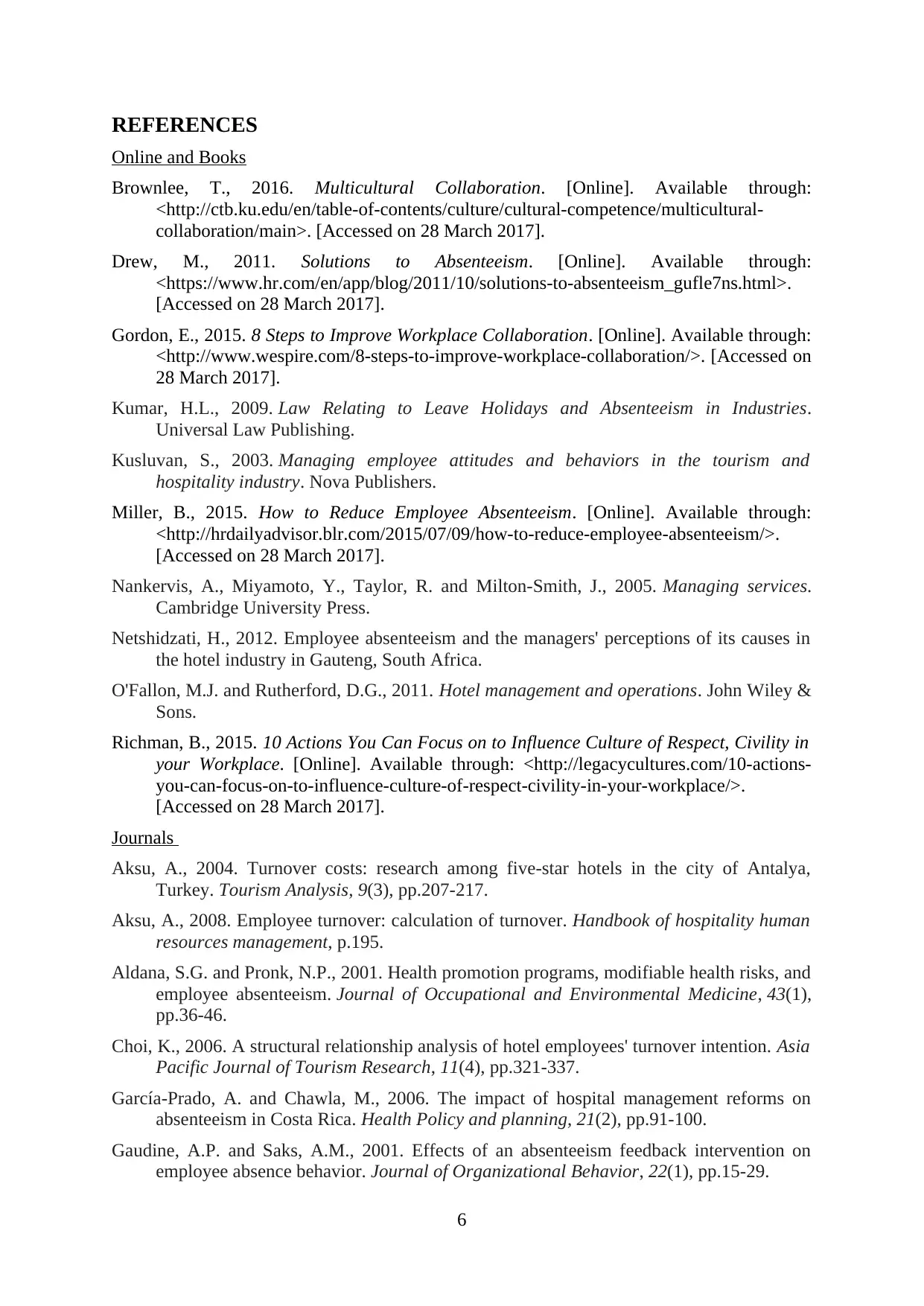
REFERENCES
Online and Books
Brownlee, T., 2016. Multicultural Collaboration. [Online]. Available through:
<http://ctb.ku.edu/en/table-of-contents/culture/cultural-competence/multicultural-
collaboration/main>. [Accessed on 28 March 2017].
Drew, M., 2011. Solutions to Absenteeism. [Online]. Available through:
<https://www.hr.com/en/app/blog/2011/10/solutions-to-absenteeism_gufle7ns.html>.
[Accessed on 28 March 2017].
Gordon, E., 2015. 8 Steps to Improve Workplace Collaboration. [Online]. Available through:
<http://www.wespire.com/8-steps-to-improve-workplace-collaboration/>. [Accessed on
28 March 2017].
Kumar, H.L., 2009. Law Relating to Leave Holidays and Absenteeism in Industries.
Universal Law Publishing.
Kusluvan, S., 2003. Managing employee attitudes and behaviors in the tourism and
hospitality industry. Nova Publishers.
Miller, B., 2015. How to Reduce Employee Absenteeism. [Online]. Available through:
<http://hrdailyadvisor.blr.com/2015/07/09/how-to-reduce-employee-absenteeism/>.
[Accessed on 28 March 2017].
Nankervis, A., Miyamoto, Y., Taylor, R. and Milton-Smith, J., 2005. Managing services.
Cambridge University Press.
Netshidzati, H., 2012. Employee absenteeism and the managers' perceptions of its causes in
the hotel industry in Gauteng, South Africa.
O'Fallon, M.J. and Rutherford, D.G., 2011. Hotel management and operations. John Wiley &
Sons.
Richman, B., 2015. 10 Actions You Can Focus on to Influence Culture of Respect, Civility in
your Workplace. [Online]. Available through: <http://legacycultures.com/10-actions-
you-can-focus-on-to-influence-culture-of-respect-civility-in-your-workplace/>.
[Accessed on 28 March 2017].
Journals
Aksu, A., 2004. Turnover costs: research among five-star hotels in the city of Antalya,
Turkey. Tourism Analysis, 9(3), pp.207-217.
Aksu, A., 2008. Employee turnover: calculation of turnover. Handbook of hospitality human
resources management, p.195.
Aldana, S.G. and Pronk, N.P., 2001. Health promotion programs, modifiable health risks, and
employee absenteeism. Journal of Occupational and Environmental Medicine, 43(1),
pp.36-46.
Choi, K., 2006. A structural relationship analysis of hotel employees' turnover intention. Asia
Pacific Journal of Tourism Research, 11(4), pp.321-337.
García-Prado, A. and Chawla, M., 2006. The impact of hospital management reforms on
absenteeism in Costa Rica. Health Policy and planning, 21(2), pp.91-100.
Gaudine, A.P. and Saks, A.M., 2001. Effects of an absenteeism feedback intervention on
employee absence behavior. Journal of Organizational Behavior, 22(1), pp.15-29.
6
Online and Books
Brownlee, T., 2016. Multicultural Collaboration. [Online]. Available through:
<http://ctb.ku.edu/en/table-of-contents/culture/cultural-competence/multicultural-
collaboration/main>. [Accessed on 28 March 2017].
Drew, M., 2011. Solutions to Absenteeism. [Online]. Available through:
<https://www.hr.com/en/app/blog/2011/10/solutions-to-absenteeism_gufle7ns.html>.
[Accessed on 28 March 2017].
Gordon, E., 2015. 8 Steps to Improve Workplace Collaboration. [Online]. Available through:
<http://www.wespire.com/8-steps-to-improve-workplace-collaboration/>. [Accessed on
28 March 2017].
Kumar, H.L., 2009. Law Relating to Leave Holidays and Absenteeism in Industries.
Universal Law Publishing.
Kusluvan, S., 2003. Managing employee attitudes and behaviors in the tourism and
hospitality industry. Nova Publishers.
Miller, B., 2015. How to Reduce Employee Absenteeism. [Online]. Available through:
<http://hrdailyadvisor.blr.com/2015/07/09/how-to-reduce-employee-absenteeism/>.
[Accessed on 28 March 2017].
Nankervis, A., Miyamoto, Y., Taylor, R. and Milton-Smith, J., 2005. Managing services.
Cambridge University Press.
Netshidzati, H., 2012. Employee absenteeism and the managers' perceptions of its causes in
the hotel industry in Gauteng, South Africa.
O'Fallon, M.J. and Rutherford, D.G., 2011. Hotel management and operations. John Wiley &
Sons.
Richman, B., 2015. 10 Actions You Can Focus on to Influence Culture of Respect, Civility in
your Workplace. [Online]. Available through: <http://legacycultures.com/10-actions-
you-can-focus-on-to-influence-culture-of-respect-civility-in-your-workplace/>.
[Accessed on 28 March 2017].
Journals
Aksu, A., 2004. Turnover costs: research among five-star hotels in the city of Antalya,
Turkey. Tourism Analysis, 9(3), pp.207-217.
Aksu, A., 2008. Employee turnover: calculation of turnover. Handbook of hospitality human
resources management, p.195.
Aldana, S.G. and Pronk, N.P., 2001. Health promotion programs, modifiable health risks, and
employee absenteeism. Journal of Occupational and Environmental Medicine, 43(1),
pp.36-46.
Choi, K., 2006. A structural relationship analysis of hotel employees' turnover intention. Asia
Pacific Journal of Tourism Research, 11(4), pp.321-337.
García-Prado, A. and Chawla, M., 2006. The impact of hospital management reforms on
absenteeism in Costa Rica. Health Policy and planning, 21(2), pp.91-100.
Gaudine, A.P. and Saks, A.M., 2001. Effects of an absenteeism feedback intervention on
employee absence behavior. Journal of Organizational Behavior, 22(1), pp.15-29.
6
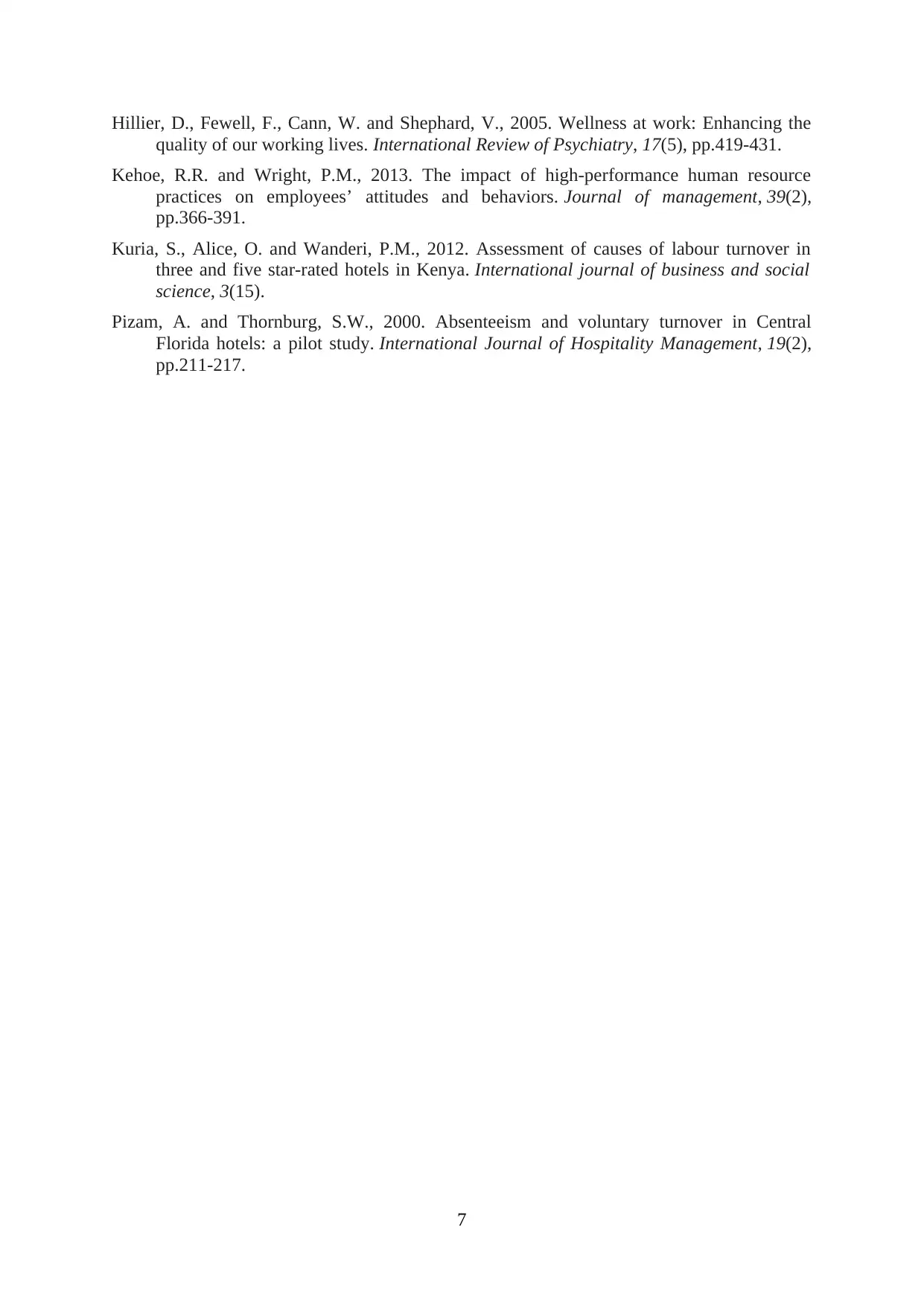
Hillier, D., Fewell, F., Cann, W. and Shephard, V., 2005. Wellness at work: Enhancing the
quality of our working lives. International Review of Psychiatry, 17(5), pp.419-431.
Kehoe, R.R. and Wright, P.M., 2013. The impact of high-performance human resource
practices on employees’ attitudes and behaviors. Journal of management, 39(2),
pp.366-391.
Kuria, S., Alice, O. and Wanderi, P.M., 2012. Assessment of causes of labour turnover in
three and five star-rated hotels in Kenya. International journal of business and social
science, 3(15).
Pizam, A. and Thornburg, S.W., 2000. Absenteeism and voluntary turnover in Central
Florida hotels: a pilot study. International Journal of Hospitality Management, 19(2),
pp.211-217.
7
quality of our working lives. International Review of Psychiatry, 17(5), pp.419-431.
Kehoe, R.R. and Wright, P.M., 2013. The impact of high-performance human resource
practices on employees’ attitudes and behaviors. Journal of management, 39(2),
pp.366-391.
Kuria, S., Alice, O. and Wanderi, P.M., 2012. Assessment of causes of labour turnover in
three and five star-rated hotels in Kenya. International journal of business and social
science, 3(15).
Pizam, A. and Thornburg, S.W., 2000. Absenteeism and voluntary turnover in Central
Florida hotels: a pilot study. International Journal of Hospitality Management, 19(2),
pp.211-217.
7
⊘ This is a preview!⊘
Do you want full access?
Subscribe today to unlock all pages.

Trusted by 1+ million students worldwide
1 out of 9
Related Documents
Your All-in-One AI-Powered Toolkit for Academic Success.
+13062052269
info@desklib.com
Available 24*7 on WhatsApp / Email
![[object Object]](/_next/static/media/star-bottom.7253800d.svg)
Unlock your academic potential
Copyright © 2020–2025 A2Z Services. All Rights Reserved. Developed and managed by ZUCOL.




